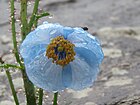Note: This is a project under development. The articles on this wiki are just being initiated and broadly incomplete. You can Help creating new pages.
Meconopsis aculeata
Meconopsis aculeata is a blue-flowered thorny species of the genus Meconopsis with a small geographical distribution restricted to specific areas of Pakistan and India, in the west Himalayas. The species was described from specimens collected here, by Royle in 1833.
Contents
[hide]- 1 Uses
- 2 Parts Used
- 3 Chemical Composition
- 4 Common names
- 5 Properties
- 6 Habit
- 7 Identification
- 8 List of Ayurvedic medicine in which the herb is used
- 9 Where to get the saplings
- 10 Mode of Propagation
- 11 How to plant/cultivate
- 12 Commonly seen growing in areas
- 13 Photo Gallery
- 14 References
- 15 External Links
Uses
Heal broken bones, Pain in the upper bodily region.
Parts Used
Chemical Composition
Primary constituents have chlorophyll, proteins sugar and amino acids. Secondary constituents contain terpenoids and alkaloids. Medicinal plants have antifungal, antibacterial and anti-inflammation activities. The present study involves medicinal plant Meconopsis aculeta which is locally available in Kashmir Himalaya. [1]
Common names
| Language | Common name |
|---|---|
| Kannada | |
| Hindi | Kanta कान्ता, Vanita वनीता. Ladak |
| Malayalam | |
| Tamil | |
| Telugu | |
| Marathi | NA |
| Gujarathi | NA |
| Punjabi | NA |
| Kashmiri | NA |
| Sanskrit | |
| English | Blue poppy,Himalayan blue poppy. Hin. Vanita, Kaliharu,. Bhotia-sarchhing, Kanta |
Properties
Reference: Dravya - Substance, Rasa - Taste, Guna - Qualities, Veerya - Potency, Vipaka - Post-digesion effect, Karma - Pharmacological activity, Prabhava - Therepeutics.
Dravya
Rasa
Guna
Veerya
Vipaka
Karma
Prabhava
Habit
Identification
Leaf
| Kind | Shape | Feature |
|---|---|---|
| Simple | Alternate | The leaves are light green and feathery. |
Flower
| Type | Size | Color and composition | Stamen | More information |
|---|---|---|---|---|
| Bisexual | White | 3-4 | Flowers Season is June - August |
Other features
List of Ayurvedic medicine in which the herb is used
- Vishatinduka Taila as root juice extract
Where to get the saplings
Mode of Propagation
How to plant/cultivate
Monocarpic erect, prickly herbs, with yellow fluid, about 40-60 cm tall. Stem simple or branched at the base, leafy throughout, covered with yellow or golden yellow color bristles, about 2-7 mm long. Tap roots narrow elongated or fusiform, about 10-14 cm long. Basal cauline leaves, variable, irregularly 1-2 pinnatipartite rarely bipinnatipartite, about 5-25 x 2-5 cm across, margin ciliate, apex obtuse, broadly incised on the lower basal segments, bristle hairs on both sides, above and beneath, petiole widened at the base, bristly, about 4-12 cm long, upper cauline leaves smaller, segments oblong, obovate to triangular, margin ciliate, apex obtuse, petiole sessile. Inflorescence raceme with about 10-20 flowers, bracteate. Flowers bisexual, axillary or terminal, about 6-8 cm across, pale blue to purple, red, pink, actinomorphic, showing bilateral symmetry, pedicels slender, spiny, about 1-15 cm long, Sepals 2, ovate-orbicular, spiny, about 1-2 cm long, caducous, petals 4, rarely 6, obovate, apex rounded or obtuse, blue, purple, red, margin entire, about 3-4 x 3-4 c-m across. Stamens numerous, filaments filiform, linear, with showy colors as petals, about 0.5-1 cm long, anthers golden yellow, basifixed, about 1-1.5 mm long. Ovary obovoid-ellipsoid or subglobose, unilocular, densely spiny, style slender, distinct or conspicuous, stigmas capitates, free or confluent on decurrent lobes, swollen at the base, about 4-10 mm long. Fruits capsules, ellipsoid-obovoid, about 10-15 mm long, dehiscing by 4-6 interplacental valves in upper apex part, rarely at the base. Seeds many, subreniform, oblong-ellipsoid, usually papillose, about 1 mm long.[3]
Commonly seen growing in areas
Tall grasslands, Meadows, Borders of forests and fields.
Photo Gallery
References
External Links
- Ayurvedic Herbs known to be helpful to treat Heal broken bones
- Ayurvedic Herbs known to be helpful to treat Pain in the upper bodily region
- Herbs with Flowers used in medicine
- Herbs with Leaves used in medicine
- Herbs with common name in Hindi
- Herbs with common name in English
- Habit - Herb
- Index of Plants which can be propagated by seeds
- Herbs that are commonly seen in the region of Tall grasslands
- Herbs that are commonly seen in the region of Meadows
- Herbs that are commonly seen in the region of Borders of forests and fields
- Herbs
- Asteraceae


